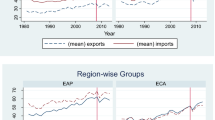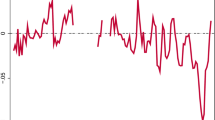Abstract
The global financial turmoil has led to an unprecedented current account adjustment in central and eastern Europe. This article investigates this issue by revisiting two approaches. The first is the current account literature based on panel econometric techniques. This article adds to the literature by showing that, although there is a large degree of parameter uncertainty associated with the choice of determinants, the implied current account benchmarks for central and eastern Europe are in a narrow range. The second approach is the external sustainability framework where we extend the analysis to take into account the importance of FDI financing. We find that both approaches point to similar conclusions on which countries were in need of a current account adjustment in central and eastern Europe in 2007. The turmoil in financial markets in 2008 set this adjustment in motion.
Similar content being viewed by others
References
Abiad A, Leigh D, Mody A (2007), International finance and income convergence: Europe is different, IMF, working paper 07/64
Adedeji OS (2001) Consumption-based interest rate and the present value model of the current account: evidence from Nigeria, IMF, working paper 01/93
Aristovnik A (2006) The determinants and excessiveness of current account deficits in eastern Europe, William Davidson Institute, working paper 827
Bergin P, Sheffrin S (2000) Interest rates, exchange rates and present value models of the current account. Econ J 110: 535–558
Bussière M, Fratszcher M, Muller G (2006) Current account dynamics in OECD and EU acceding countries. J. Econ Integration 21(3): 593–818
Calderon CA, Chong A, Loayza NV (2002) Determinants of current account deficits in developing countries. Contributions to Macroeconomics 2 (1), Article 2
Campa J, Gavilan A (2007), Current accounts in the euro area: an intertemporal approach, Banco de Espana, documentos de trabajo, 638
Chinn M (2005), Getting serious about the twin deficits, Council Special Report 10, Council of Foreign Relations
Chinn M, Prasad E (2003) Medium-term determinants of current accounts in industrial and developing countries: an empirical exploration. J Int Econ 59: 47–76
De Santis R, Lührmann M (2008) On the determinants of net international portfolio flows: a global perspective. J Int Money Finance 28(5): 880–901
Debelle G, Faruque H (1996) What determines the current account? A cross-sectional and panel approach, IMF, working paper, 96/58
Doisy H, Hervé K (2003) Les implications des deficits courants des PECO. Econ Int 95: 59–88
Galí J, Lopez JD, Valles J (2007) Understanding the effects of government spending on consumption. J Eur Econ Assoc 5(1): 227–270
Glick R, Rogoff K (1995) Global versus country-specific productivity shocks and the current account. J Monet Econ 35: 159–192
Gruber J, Kamin S (2005) Explaining the global pattern of current account imbalances, Board of Governors of the Federal Reserve System International Finance, discussion papers, 846
Hermann S, Jochem A (2005), Determinants of current account developments in the central and east European EU member states—consequences for the enlargement of the euro area, Deutsche Bundesbank, discussion paper series 1: Economic Studies, 32
IMF (2006) Methodology for CGER exchange rate assessments, Research Department, IMF, November 2006. Available at: http://www.imf.org/external/np/pp/eng/2006/110806.pdf
Kraay A, Ventura J (2000) Current accounts in debtor and creditor countries. Quart J Econ 115(4): 1137–1166
Krugman P (1999) Balance sheets, the transfer problem and financial crises. Int Tax Public Finance 6: 459–472
Lane P (2006) The real effects of EMU, CEPR, discussion paper 5536
Lane P, Milesi-Ferretti G (2006) Capital flows to central and eastern Europe, IMF, working paper, 06/188
Lucas L (1990) Why doesn’t capital flow from rich to poor countries?. Am Econ Rev 80(2): 92–96
Nason JM, Rogers JH (2006) The present-value model of the current account has been rejected: round up the usual suspects. J Int Econ 68(1): 159–187
Obstfeld M, Rogoff K (1994) The intertemporal approach to the current account, NBER, working paper 4893
Rahman J (2008) Current account developments in new member states of the European Union: equilibrium, excess and EU-Phoria, IMF, working paper 08/92
Reinhard C, Rogoff K (2004) Serial default and the “paradox” of rich-to-poor capital flows. Am Econ Rev 94(2): 53–58
Sachs JD (1981) The current account and macroeconomic adjustment in the 1970s. Brookings Pap Eco Ac 1: 201–268
Zanghieri P (2004) Current account dynamics in new EU members: sustainability and policy issues, CEPII research center, working paper 07
Author information
Authors and Affiliations
Corresponding author
Rights and permissions
About this article
Cite this article
Ca’ Zorzi, M., Chudik, A. & Dieppe, A. And then current accounts (over)adjusted. Empir Econ 43, 245–270 (2012). https://doi.org/10.1007/s00181-011-0476-x
Received:
Accepted:
Published:
Issue Date:
DOI: https://doi.org/10.1007/s00181-011-0476-x
Keywords
- Current account
- Financial flows
- Central and eastern Europe
- Panel data
- Model uncertainty
- External sustainability




